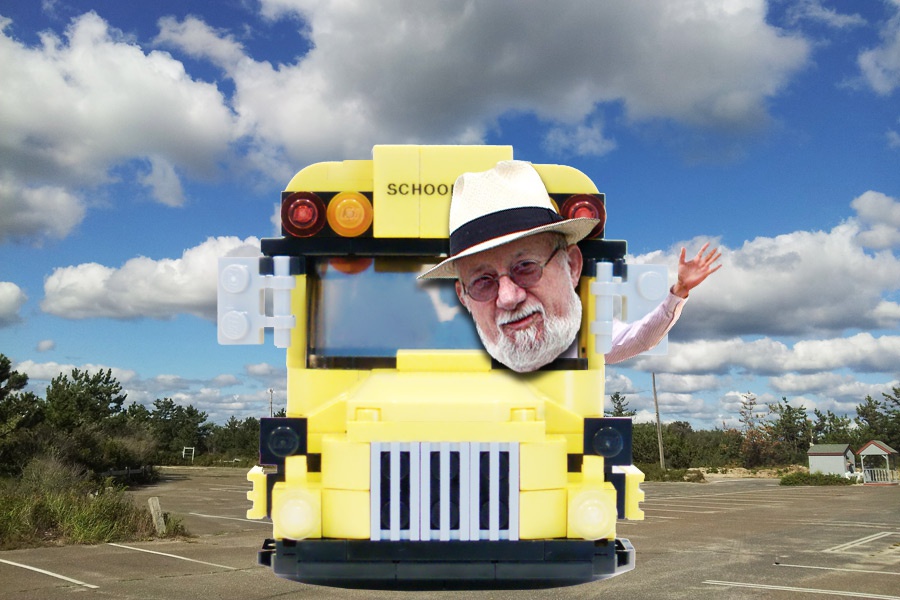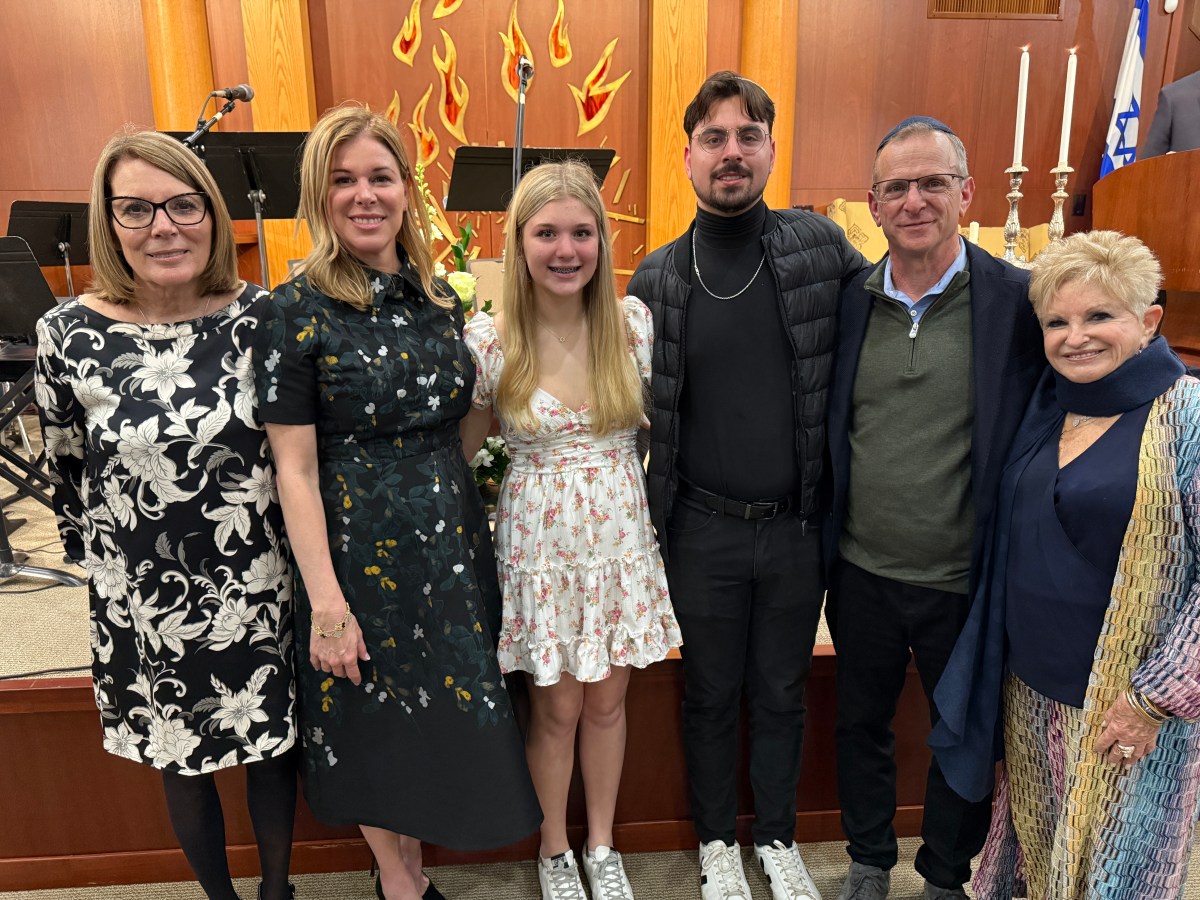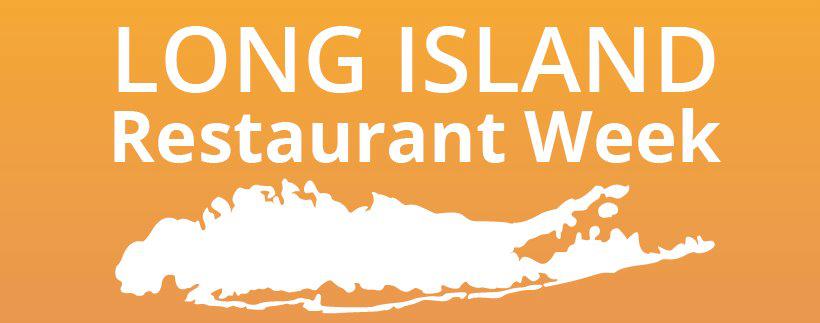And on Your Right... Diary of a Hamptons Bus Tour Guide

In mid-August, I got an email from a person I did not know, John Mann, telling me he was getting married to his girlfriend Libby in Montauk on September 7 and wanted to hire a bus and a tour guide to drive about 30 people around the Hamptons for the day.
“I was recently in the Montauk Bookshop,” he wrote “and the owner suggested that I should reach out to you as you are the ‘be all and end all when it comes to Hamptons local knowledge.’ Do you know of anyone or could you suggest anyone that might be able to help us?”
It’s hard to pass up that kind of flattery.
Also, 10 years ago, I gave tours for members of the 92nd Street Y. They’d come out in a full-size, regular bus and I’d tour from Westhampton to Amagansett with a microphone in the front seat. I did that one day in the spring every year for three years. My tour was a listed thing to do in their catalogue.
The bus rented for this wedding was a fabulous all-white rock-star bus, fitted out in mahogany and leather with 32 captain’s chairs, a cocktail table toward the front and a curving leather couch at the back.
In front of a panel, there was the driver and tour guide seat of less luxurious material and importance. I’d be on the microphone in the front. This was not like the 92nd Street Y bus where I stood at the open front of the bus with a microphone and faced the occupants. Also, when I came into the beautiful back to introduce myself, I saw this was a whole different crowd on this bus. For the 92nd Street Y it was mostly retired people who didn’t know one another. This crowd was family and friends, old and young, very happy and chattering away.
I tipped my hat, introduced myself, welcomed them, and went out the passenger door and came back in by climbing up the three steps into the front across from the driver, a black man with what I thought was a Jamaican accent. I introduced myself. His name was Rene Leonard. I was mistaken about his accent as it later turned out.
The plan was to give a morning tour in Napeague and Amagansett, then go to Sag Harbor, break for an hour and a half so they could walk around town and shop and eat, then at 1 p.m. head over to East Hampton, let them do a little shopping there, then head back to Sole East, where they were staying.
Heading west out of Montauk, I had the bus turn off to the right at Napeague Meadow Road, cross the tracks and come to a halt a few hundred yards beyond them where you could see the Napeague Art Barge, the tall metal tower and the abandoned concrete blockhouse next to it on pilings in the marshland there. I clicked on my microphone.
“The Art Barge is an art school,” I told them, “created when a huge Manhattan houseboat was towed out and pushed up onto the beachfront property they owned in the spring of 1960. This was before zoning. You couldn’t do this today. It was soon shored up and foundations put under it. There it is. It was and is the successful dream of its founder, Victor D’Amico.”
I told them the tower was erected about 100 years ago by Marconi, who created the service so people on shore, in the blockhouse, could contact ships at sea by Morse code.
“There was no radio then,” I said. “So this was this new way to keep track of ships. Think of the movie Titanic and the radio operator with the earphones.”
I pointed out that if you looked halfway up the tower, you’d see an osprey nest. I told them the osprey was the largest bird on the East End, with a wingspan sometimes of six feet or more. Nobody was going to go up there and battle with those birds to take the nest down.
We stopped again at what is known as the The Fish Farm a half a mile further down. This consists of what seems from the road to be an assemblage of very large abandoned and decrepit buildings made of wood and corrugated metal sitting waterfront on the bay.
“You go in here and park, walk through packs of geese and chickens, past a cage in which Rhodesian Ridgebacks are being raised, past huge vats filled with flounder, past a fish packing house, a country store and a kitchen with an outdoor counter and chalkboard menu where you order food, and go to some picnic tables overlooking the water. The food is lobster, fries, fish, chicken and soft drinks. Bring your own beer. The store, by the way, is run by some French people who make delicious pastries they display in a showcase inside.”
Surely this is the most remarkable establishment in the Hamptons. I told them the history of the place.
“As you see, we sit alongside a spur from the railroad that goes down to the this place. This was one of six fish factories built along the arc of this bay in the 1880s. Draggers would come in with tons of tiny bunker fish in their holds, they’d be taken ashore and boiled down into paste in huge vats, then shoveled into barrels and shipped by railroad to factories in Queens to be bottled into glue.” I let that sink in. “The vats were open to the air. The whole place stank. I got here as a teenager in 1956. It smelled, but the last of the six factories closed around 1960. This is the only one that was not bulldozed down.”
I took them along Bluff Road and down to Atlantic Avenue Beach, where I showed them the Coast Guard Station being restored and told them about how the Nazis landed there during World War II.
“There were four of them. They came across the Atlantic in a German submarine and got taken through the surf by sailors in a rubber boat on a foggy night in June of 1942. They had boxes of explosives with them, and their intention was to blow up department stores, bridges, aluminum plants and railroad junctions. Wouldn’t you know it, they came up on the beach, in full Nazi uniforms, almost right in front of the Coast Guard Station. Also there was a naval radio station. The old wooden snack bar on the dunes in front of us I believe was a lookout for the Navy radio people. Not a good idea to come ashore here.”
This is a fascinating story, and I was continuing on with it, telling about their ultimate arrests and encounter with the electric chair less than two months later, when out the front window of the bus, I saw a man I know at the wheel of a car, looking up at me. He was facing the bus where we had stopped, waiting for a moment when he could drive past us to head back up to Bluff Road.
Here I was, a tour guide with a microphone in the front end of a bus. He was Andy Sabin, a wealthy resident of these parts who a month ago I had joined on his 10-passenger private jet to North Dakota, where he has a factory and where one of my sons lives.
Up in the sky I recall him coming back after talking to the pilot to tell that we were now traveling 605 miles an hour; now he was looking up at me, the founder, President and Editor-in-Chief of Dan’s Papers, and I was a tour guide on a bus. Hmmm! He now had a place to drive through. There he went.
From Atlantic Avenue Beach, I had the driver take us up Abrahams Path toward Springs Fireplace Road and the turn toward the Pollock-Krasner House. Along the way, I pointed out the modest houses where many local fishermen and baymen live.
“These are the descendants of the original settlers from England,” I said. “They still fish. They call themselves Bonackers, speak English with a unique accent and are a pride of this community.”
We passed the big kids park on Abrahams Path. Ball field, soccer field, tennis, skateboarding, track, indoor hockey arena. I mentioned that this fabulous park had been largely built with money provided by a low-profile but very generous billionaire who later, as it turned out, found his money was a fake. His money had been “invested” by Bernie Madoff. Now he was broke.
“Had Madoff not said all this money was there, this park may never have been built,” I said. And it’s true.
Then, as we turned off Abrahams Path onto Springs Fireplace Road, I said look out the window as we pass the spot where Abstract Expressionist painter Jackson Pollock had died driving his convertible car off the road.”
“He was with two young women, 20 years his junior,” I said. “His wife was in Paris.”
It’s fun giving a tour.
At the Pollock-Krasner house, we piled out of the bus to stand in the driveway and look out at the lawn in the back of the house where the great man lived and painted his famous drip paintings in the late 1940s and early 1950s. He also had a big, separate studio on the property. His wife, Lee Krasner, also painted, but in an upstairs bedroom.
The director of this restored home, now a museum, Helen Harrison, seeing this white rock-star bus out on the street and this crowd of 30 people standing in the driveway, came out to say hello.
She described how Springs was back then. Just 400 people lived in the community. There was no plumbing in the house. Pollock sometimes swapped paintings for groceries at a nearby country store.
“Any of you people live around here?” she asked. Almost none did. Mostly, they told her, they were from Ohio. She’d give a tour of the house now, she said, but there was a class in session in the house, so it was not possible. Maybe another time.
During the 15-minute drive to Sag Harbor, I described how that town had developed as a whaling town, in the first half of the 19th century. I described Long Wharf, the centerpiece of the town, which had 100 oceangoing whaling ships tied up there during that era and how the people today had kept the town as this classic little Victorian village to this day.
We parked in the big lot behind Main Street, and I got my first taste of what it was like to be a hired tour guide for a wedding party.
On board, the woman running the tour in the back told everyone to come out and enjoy a walk through town for an hour and a half—the driver and I had come out to stand by the door at this point—and soon everybody was gone. Then she turned to us and said she was willing to go into town and get something for the driver at a deli or something and did I know of one. I was free to go, she said, so long as I was back, but he had to stay by the bus. I thought I could go get him a sandwich, but she said no, she would, and so I told her to go to Conca D’Oro, which is a pizzeria where she could get sandwiches and other things, and she asked him what he wanted, he told her and then she was gone.
After he left, I talked to the driver, standing down there in the sun for a while. I had seen he had a hardcover book about science experiments through history and asked him about that, and he said he loved history. Turns out he was a part-time bus driver, but a full-time photo-journalist. He’s from Zambia, spent years living in London and has been in war zones, most notably in Afghanistan, Iraq and South Africa.
“Now I’m settled down a bit. Wife and kids, and we live in East Meadow. And I’m not risking my life so much.” He didn’t know much about the Hamptons, but was friends with Geoff Lynch. Did I know him? I sure did. He heads up the Hampton Jitney.
I wandered around Sag Harbor for that hour and a half after that, trying to look at it through tourists’ eyes. I sat and had a Bloody Mary and salad on the front porch of the American Hotel. Jules Feiffer came over for a while. So did his girlfriend J.Z. Holden, who has just written a novel called Illusion of Memory. At one point, Jules went back out to his car and they gave me a copy, which she inscribed.
When everybody was back in the bus, happy, well-fed and carrying shopping bags, we pressed on. I had the bus driver take us up Garden Street, this narrow and charming little street lined with cottages from the whaling days, and I pointed out where Betty Friedan lived. We drove further on, and I pointed out the library, the Sag Harbor Whaling and Historical Museum, then onto Union Street where we stopped in front of the Old Whalers’ Church.
“This was the tallest building on Long Island for nearly 100 years,” I said over the microphone. “It stood 180 feet high, and it’s on this hilltop so it’s even higher. The steeple was knocked off in the Hurricane of ’38, however, so it’s not so high now. They’re raising money to put it back up.”
We then drove further up Union Street, past the Catholic Church, the Episcopal Church, then went way up to the brow of Turkey Hill where we stopped briefly to look at a stone monument on an empty lot between some of the homes there.
“The monument marks the spot where a fort was built by American troops during the War of 1812,” I said. “They had a big cannon up here. None of these houses were here. You could look down at Long Wharf back then and from the top of this hill, this cannon was fired to drive off British troops who had landed on Long Wharf intending to burn down Sag Harbor.”
That’ll hold them, I thought. I then had the driver take us down High Street to where Billy Joel lives on Bay Street facing the yachts, then took the bus up Main Street and out toward East Hampton.
On the way, I was told by the tour director that they didn’t want to stop in East Hampton, just point things out. They’d had enough shopping.
I took them through the estate section of East Hampton, we admired the Japanese trees that line Lilly Pond Lane, then we went down to Main Beach, where I told them that since this beautiful pavilion had first been built 100 years ago, it had been torn down and rebuilt exactly as before at least twice in my lifetime.
“It would get too weather beaten,” I said.
I also told them that for the rich the single most coveted item to have in the Hamptons was a cabana at this beach. There are only about 80 of them. “Also,” I said, “there’s a company that rates the best beaches in America. This year the winner is right here, Main Beach, East Hampton.” People climbed down from the bus briefly to take pictures, both of the beach and the pavilion.
From here, we drove down Main Street East Hampton. I pointed out Town Pond and the mute swans, the library, Guild Hall, Clinton Academy, the three beautiful old wooden windmills, two at the west end of town and one on the town green to the east, then the mansion that was the summer white house for President John Tyler because he had married an East Hampton girl. And then we were off to Montauk.
At Solé East, Rene and I jumped down from the front and stood by the door as all the passengers disembarked. Many thanked us. Some of the men shook our hands. A big white tent was being erected in the backyard of Solé East near where we were parked. Rene and I went into the back of the bus to clean it a bit and see if they had left anything. There was a canvas bag with half a dozen bags of potato chips in it, some copies of Dan’s Papers. I took out a bag of potato chips.
The woman running the event came back on the bus. “Now you’ve both been paid, is that correct?” she asked. I acknowledged that I had been—by the bride, earlier, in a cash handshake—and Rene said he had but there was some money due on the bus rental. She took out a checkbook. Then she saw my chips.
“I hope this is all right,” I told her. She picked up the canvas bag and said, oh, take some more, take all you want, and I demurred and said oh, just this one is fine. Then she left.
Rene and I talked some more in the sunshine alongside the bus.
I said it was all new to me to be a wedding tour guide. I had never been in this position before. “I found myself thinking, as the people got off the bus, what if someone wanted to give me a tip? Would I take it?” We started laughing. “I guess I would,” I continued. “I also felt she was half accusing me of stealing potato chips.”
We said good-bye to one another, hugged, and I told him I’d like us to see one another again and he agreed. I told him I wanted to see his photo portfolio. We exchanged business cards.
And so we left. Back home, I told my wife not to disturb me, lay down on the couch in the living room and fell fast asleep for an hour. What a nice day.
After that, I emailed the groom. “I want you wish you the best wedding ever, all the family you want, and long life.” I very much enjoyed giving this tour.
But, I think, not another very soon.




